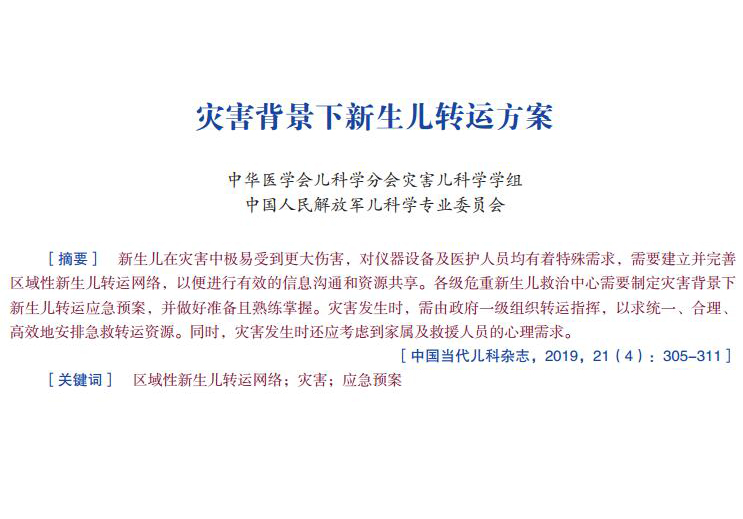 PDF(1095 KB)
PDF(1095 KB)


Neonatal transport for disasters
Group of Pediatric Disaster, Pediatric Society, Chinese Medical Association, Pediatrics Committee, Medical Association of Chinese People's Liberation Army
Chinese Journal of Contemporary Pediatrics ›› 2019, Vol. 21 ›› Issue (4) : 305-311.
 PDF(1095 KB)
PDF(1095 KB)
 PDF(1095 KB)
PDF(1095 KB)
Neonatal transport for disasters
Neonates are vulnerable to greater damage in disasters and thus have special needs for equipment and medical staff. It is necessary to establish a regional neonatal transport network, in order to provide a platform for effective information communication and resource sharing. Neonatal care centers for critically ill neonates at all levels need to develop a disaster response plan for neonatal transport, and master this plan. In case of disasters, neonatal transport should be directed at the government level, in order to arrange emergency transport resources in a unified, reasonable and efficient way. Meanwhile, the psychological needs of family members and rescue staff should be taken into account.

Regional neonatal transport network / Disaster / Response plan
[1] 中国医师协会新生儿科医师分会; 孔祥永, 封志纯, 等. 新生儿转运工作指南(2017版)[J]. 发育医学电子杂志, 2017, 5(4):193-197.
[2] American Academy of Pediatrics, American College of Emergency Physicians, American College of Surgeons Committee on Trauma, et al. Equipment for ground ambulances[J]. Prehosp Emerg Care, 2014, 18(1):92-97.
[3] Barfield WD, Krug SE, Kanter RK, et al. Neonatal and pediatric regionalized systems in pediatric emergency mass critical care[J]. Pediatr Crit Care Med, 2011, 12(6 Suppl):S128-S134.
[4] Kissoon N; Task Force for Pediatric Emergency Mass Critical Care. Deliberations and recommendations of the Pediatric Emergency Mass Critical Care Task Force:executive summary[J]. Pediatr Crit Care Med, 2011, 12(6 Suppl):S103-S108.
[5] Cohen R, Murphy B, Ahern T, et al. Regional disaster planning for neonatology[J]. J Perinatol, 2010, 30(11):709-711.
[6] Lowe CG. Pediatric and neonatal interfacility transport medicine after mass casualty incidents[J]. J Trauma, 2009, 67(2 Suppl):S168-S171.
[7] Disaster Preparedness Advisory Council. Medical countermeasures for children in public health emergencies, disasters, or terrorism[J]. Pediatrics, 2016, 137(2):e20154273.
[8] 孔祥永, 封志纯. 重视改进新生儿转运[J]. 中国实用儿科杂志, 2016, 31(9):667-669.
[9] 李雪, 史源. 灾害背景下NICU的应急准备方案[J]. 中国当代儿科杂志, 2017, 19(10):1033-1037.
[10] Schwartz HP, Bigham MT, Schoettker PJ, et al. Quality metrics in neonatal and pediatric critical care transport:a national delphi project[J]. Pediatr Crit Care Med, 2015, 16(8):711-717.
[11] Gausche-Hill M, Ely M, Schmuhl P, et al. A national assessment of pediatric readiness of emergency departments[J]. JAMA Pediatr, 2015, 169(6):527-534.
[12] Phillips P, Niedergesaess Y, Powers R, et al. Disaster preparedness:emergency planning in the NICU[J]. Neonatal Netw, 2012, 31(1):5-15.
[13] Barfield WD, Krug SE; Committee on Fetus and Newborn, et al. Disaster preparedness in neonatal intensive care units[J]. Pediatrics, 2017, 139(5):e20170507.
[14] Chang AS, Berry A, Jones LJ, et al. Specialist teams for neonatal transport to neonatal intensive care units for prevention of morbidity and mortality[J]. Cochrane Database Syst Rev, 2015, (10):CD007485.
[15] Brown SA, Richards ME, Elwell EC, et al. Geographical information systems for mapping maternal ground transport to level Ⅲ care neonatal centers[J]. Am J Perinatol, 2014, 31(4):287-292.
[16] Campbell DM, Dadiz R. Simulation in neonatal transport medicine[J]. Semin Perinatol, 2016, 40(7):430-437.
[17] Janvier A, Lantos J; POST Investigators. Ethics and etiquette in neonatal intensive care[J]. JAMA Pediatr, 2014, 168(9):857-858.
[18] Rathod D, Adhisivam B, Bhat V. Neonatal transport in resource restricted settings:a simple clinical score at arrival and its role in predicting mortality[J]. Int J Emerg Med, 2014, 7(Suppl 1):1-2.
[19] Bellini S. Postresuscitation care and pretransport stabilization of newborns using the principles of STABLE transport[J]. Nurs Womens Health, 2015, 19(6):533-536.
[20] Panico M. New technologies applied to neonatal transport[J]. Ital J Pediatr, 2015, 41:A26.
[21] Schonfeld DJ, Demaria T; Disaster Preparedness Advisory Council and Committee on Psychosocial Aspects of Child and Family Health. Providing psychosocial support to children and families in the aftermath of disasters and crises[J]. Pediatrics, 2015, 136(4):e1120-e1130.